[/caption]
Greetings, fellow SkyWatchers! Heads up to observers in most of Asia, Australia, Europe, Africa and South America for Saturday night’s partial lunar eclipse. For everyone else, be sure to keep a watch on western ecliptic plane as Mercury, Venus and Saturn join together for a dazzling weekend show! Although the Moon, will keep us in the “pits” we’ll still take a look at the “Eye of the Archer” and go “Butterfly” hunting. Now, let’s wait on night and slip outside… Together.
Friday, August 15, 2008 – It’s going to be very hard to ignore the presence of the Moon tonight – or the conjunction that’s about to happen in the west! Just in case you get clouded out tomorrow, be sure to have a look a Mercury, Venus and Saturn getting closer by the minute. But, oh my… It’s going to get even better yet because the Moon is also creeping closer and closer to Earth’s shadow!
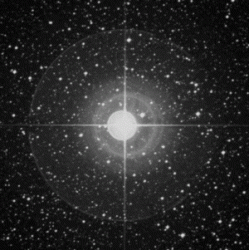 Think having all this Moon around is the pits? Then let’s venture to Zeta Sagittarii (RA 19 02 36 Dec -29 52 48) and have a look at Ascella – the “Armpit of the Centaur.” While you’ll find Zeta easily as the southern star in the handle of the teapot formation, what you won’t find is an easy double. With almost identical magnitudes, Ascella is one of the most difficult of all binaries. Discovered by W. C. Winlock in 1867, the components of this pair orbit each other very quickly: in little more than 21 years. While they are about 140 light-years away, this gravitationally-bound pair waltz no further apart than do our own Sun and Uranus!
Think having all this Moon around is the pits? Then let’s venture to Zeta Sagittarii (RA 19 02 36 Dec -29 52 48) and have a look at Ascella – the “Armpit of the Centaur.” While you’ll find Zeta easily as the southern star in the handle of the teapot formation, what you won’t find is an easy double. With almost identical magnitudes, Ascella is one of the most difficult of all binaries. Discovered by W. C. Winlock in 1867, the components of this pair orbit each other very quickly: in little more than 21 years. While they are about 140 light-years away, this gravitationally-bound pair waltz no further apart than do our own Sun and Uranus!
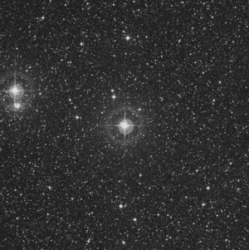 Too difficult? Then have a look at Nu Sagittarii (Ain al Rami), or “The Eye of the Archer” (RA 18 54 10 Dec -22 44 41). It’s one of the earliest known double stars and was recorded by Ptolemy. While Nu 1 and Nu 2 are not physically related to one another, they are an easy split in binoculars. Eastern Nu 2 is a K-type giant which is about 270 light-years from our solar system, but take a very close look at the western Nu 1. While it appears almost as bright, this one is 1850 light-years away! As a bonus, power up the telescope, because this is one very tight triple star system.
Too difficult? Then have a look at Nu Sagittarii (Ain al Rami), or “The Eye of the Archer” (RA 18 54 10 Dec -22 44 41). It’s one of the earliest known double stars and was recorded by Ptolemy. While Nu 1 and Nu 2 are not physically related to one another, they are an easy split in binoculars. Eastern Nu 2 is a K-type giant which is about 270 light-years from our solar system, but take a very close look at the western Nu 1. While it appears almost as bright, this one is 1850 light-years away! As a bonus, power up the telescope, because this is one very tight triple star system.
 Saturday, August 16, 2008 – Today is the birthday of none other than Pierre Méchain (1744), Charles Messier’s well-known assistant. As a cartographer and astute mathematician, Méchain was a comet hunter as well, and much to his credit, was able to calculate the orbits of his discoveries. This quiet man contributed nearly a third of the objects found in what we now refer to as the “Messier Catalog,” and was quite probably one of the first to realize just how many galaxies reside in the Virgo region. Although war and disease would bring an early end to this distinguished astronomer’s life, Méchain became the director of the Paris Observatory and traveled to England where he met Sir William Herschel.
Saturday, August 16, 2008 – Today is the birthday of none other than Pierre Méchain (1744), Charles Messier’s well-known assistant. As a cartographer and astute mathematician, Méchain was a comet hunter as well, and much to his credit, was able to calculate the orbits of his discoveries. This quiet man contributed nearly a third of the objects found in what we now refer to as the “Messier Catalog,” and was quite probably one of the first to realize just how many galaxies reside in the Virgo region. Although war and disease would bring an early end to this distinguished astronomer’s life, Méchain became the director of the Paris Observatory and traveled to England where he met Sir William Herschel.
Mark your StarGazer calendar for tonight, because it’s going to be one awesome show! Starting off just after sunset on the western horizon, look for Mercury, Saturn and Venus to gather together in a tight triangle to watch as the Moon heads quietly for the Earth’s shadow. A lunar eclipse is about to occur!
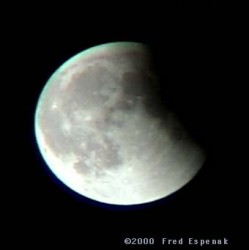 Although it will only be a partial, the event will be visible over most of Asia, Australia, Europe, Africa and South America. But, don’t sell it short. This is a significant event since the Moon will pass deep inside Earth’s umbral shadow at its maximum – an umbral magnitude of 0.8! The eclipse will begin at 19:35:45 UT and will end about three hours later, with 21:10:08 as the moment of greatest eclipse.
Although it will only be a partial, the event will be visible over most of Asia, Australia, Europe, Africa and South America. But, don’t sell it short. This is a significant event since the Moon will pass deep inside Earth’s umbral shadow at its maximum – an umbral magnitude of 0.8! The eclipse will begin at 19:35:45 UT and will end about three hours later, with 21:10:08 as the moment of greatest eclipse.
Begin watching at 18:23:07 UT as the Moon begins to enter the shadow; it will not fully exit the shadow until 23:57:06 UT. One of the most breathtaking adventures you can undertake is to watch the Moon through a telescope during an eclipse – both in ingress and egress. Craters take on new dimensions and subtle details light up as the shadow seems to race across the surface. And if you are lucky enough to see it at maximum, be sure to look at the stars near Moon. What a wonder it is to behold what is normally hidden by the light!
And what else is about to be hidden? Neptune! Less than a degree to the north of the lunar limb, the “King of the Sea” is about to be occulted. Check out IOTA for times and locations… Or just have a look for yourself. Enjoy your eclipse experience and remember to try your hand at photography!
Sunday, August 17, 2008 – Today in 1966 Pioneer 7 was launched. It was the second in a series of satellites sent to monitor the solar wind, and it also studied cosmic rays and the interplanetary magnetic field. Although the Moon will be along soon, return to previous study star Lambda Scorpii and hop three fingerwidths northeast to NGC 6406 (RA 17 40 18 Dec -32 12 00)… We’re hunting the “Butterfly!”
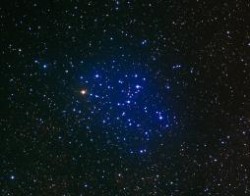 Easily seen in binoculars and tremendous in the telescope, this brilliant 4th magnitude open cluster was discovered by Hodierna before 1654 and independently found by de Chéseaux as his Object 1 before being cataloged by Messier as M6. Containing about 80 stars, the light you see tonight left its home in space around the year 473 AD. M6 is believed to be around 95 million years old and contains a single yellow supergiant – the variable BM Scorpii. While most of M6’s stars are hot, blue, and belong to the main sequence, the unique shape of this cluster gives it not only visual appeal, but wonderful color contrast as well.
Easily seen in binoculars and tremendous in the telescope, this brilliant 4th magnitude open cluster was discovered by Hodierna before 1654 and independently found by de Chéseaux as his Object 1 before being cataloged by Messier as M6. Containing about 80 stars, the light you see tonight left its home in space around the year 473 AD. M6 is believed to be around 95 million years old and contains a single yellow supergiant – the variable BM Scorpii. While most of M6’s stars are hot, blue, and belong to the main sequence, the unique shape of this cluster gives it not only visual appeal, but wonderful color contrast as well.
Wishing you clear skies and good luck!
This week’s awesome images are: Partial Lunar Eclipse: Credit: Fred Espenak – NASA, Zeta Sagittarii: Ascella – Credit: Palomar Observatory courtesy of Caltech, Nu Sagittarii: The Eye of the Archer – Credit: Palomar Observatory courtesy of Caltech, and M6: Credit – NOAO/AURA/NSF.

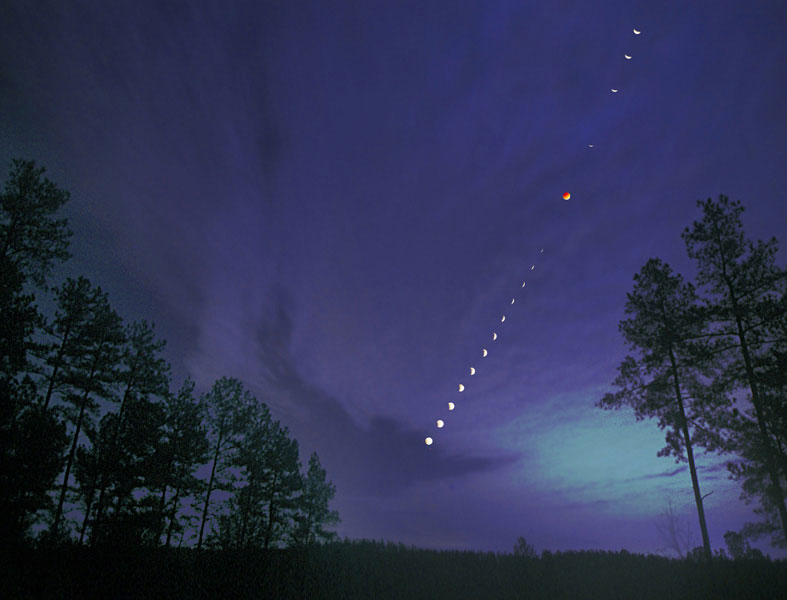
It is Currently 9:20 pm GMT, 15th of August 2008. I am on the North Coast of Egypt, and there is an eclipse visible. What kind is it??
it’s a lunar eclipse! more specifically, it is a partial lunar eclipse. 100% penumbral – 80% umbral.